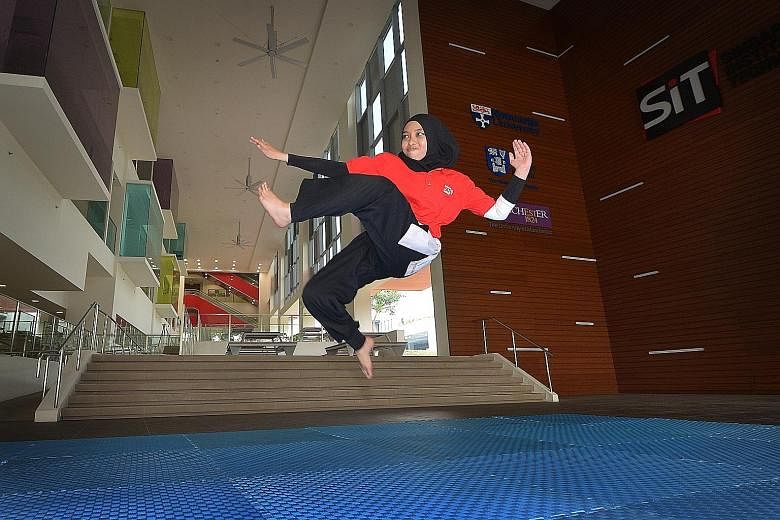She might not look like the part, but Ms Haziqah Haron is into martial arts - specifically, the 22-year-old is a silat exponent who has taken part in numerous competitions.
It all started when she was 17 and in the first year of polytechnic. A silat senior encouraged her to try it out for a few weeks. After a few training sessions, her interest grew.
"The cultural aspect would be the main difference between silat and other martial arts. Silat allows me to learn not only about self-defence, but also about my culture," said Ms Haziqah, a food and human nutrition student at the Singapore Institute of Technology (SIT).
Practising silat also keeps her fit.
The training sessions - conducted two or three times a week, for up to three hours - are designed to maximise the practitioner's endurance, strength, agility and speed.
These factors are crucial, especially when one is facing off against an opponent.
Ms Haziqah usually competes once a year. Last year, she won two bronze medals at the National Pencak Silat Championship.
When a competition draws near, the number of training sessions increases to five or six times a week.
On days when there are no training sessions, she jogs and carries on with her own physical training to maintain or improve her stamina and fitness.
She does all this because silat is a demanding sport.
Besides kicking and punching, key moves include take-downs, which employ techniques such as scissor sweeps.
A pesilat (a person who practises silat) is expected to remain graceful even while trying to deliver punches to his opponent. Bunga-bunga - hand movements made by the pesilat while he is some distance away from his opponent - serve two purposes.
"Bunga-bunga can make our movements look more graceful - a reflection of the Malay culture, where grace is highly valued," said Ms Haziqah.
The moves might also be used to veil the pesilat's true intent, which could be to throw a punch, she said.
Meanwhile, pasang kuda-kuda, or stances, allow the pesilat to attack and defend effectively.
"From a particular pose or position, we can launch punches and kicks or execute blocks. Kuda-kuda also lower our centre of gravity, so we are more stable and less likely to fall," said Ms Haziqah, adding that such moves make silat different from other martial arts.
They are not easy to learn.
For Ms Haziqah, learning the scissor kick to take down an opponent was the most difficult part.
Bruises are common in silat as it is a contact sport. When Ms Haziqah first started practising silat, she sprained her elbow, she said.
There are two categories in silat - tanding (match) and seni (artistic). You can specialise in one, or both, as Ms Haziqah does.
Although silat is unique, it is also similar to other sports in that it teaches us discipline, perseverance and courage, she said.
ART OF PRECISION
Physically, silat training allows practitioners to improve body coordination, as well as gain precision, flexibility, agility and power in their movements, said Assistant Professor Benjamin Soon, who is in charge of a new physiotherapy programme at SIT.
Such skills are required during both combat matches and solo performances, where there are choreographed movements.
Silat also helps to hone one's senses and ability to focus, because practitioners must be aware of their surroundings and the actions of their opponents. This, in turn, helps them to raise their self-awareness, said Prof Soon.
Moreover, silat helps to improve one's breathing techniques and core body strength.
Besides physical benefits, silat practitioners gain self-confidence and discipline.
During a match, they need strength, flexibility and power, in both their arms and legs. They also need to be nimble, so they can quickly counter-attack when an opponent strikes.
The sport involves considerable legwork, which includes maintaining a horse stance, side stepping, lunging, sliding, jumping and kicking, said Prof Soon.
Practising silat helps strengthen core and leg muscles, which can aid in daily activities such as lifting items or pushing heavy loads. It also reduces the chances of sustaining a back injury, Prof Soon added.
Warm-up exercises should include side jumps, lunges, light runs and abdominal crunches, which engage the leg and abdominal muscles, he said.
Dynamic stretching of the shoulder and leg muscles should be incorporated too, especially of the quadriceps, hamstrings and groin muscles, to improve flexibility.
This can be done by repeatedly swinging and kicking the legs, or forward punching with the arms - mimicking movements used during the sport, Prof Soon said.
As silat is a combat sport, there is always a risk of getting injured when sparring with an opponent.
Proper protective gear is essential. One must also know how to break a fall properly - throwing an opponent off the ground scores the highest points during competitions, said Prof Soon.


